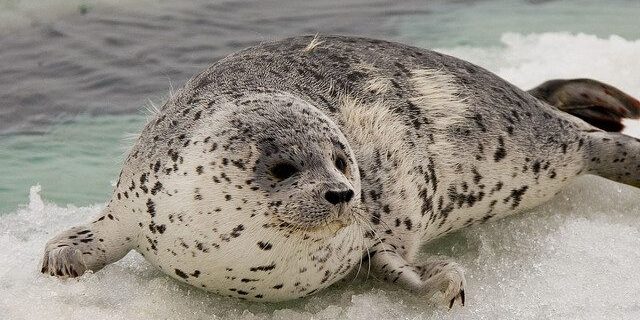An Unusual Mortality Event (UME) was designated by the National Oceanic and Atmospheric Administration (NOAA) for ice seals in the Bering Strait region in 2019. With dozens of ice seal strandings last year in the Bering Sea, researchers from NOAA Fisheries plan to set sail this April to find out more information about how ice seals are doing with less sea ice, and what might be causing so many to become sick or die.
KNOM’s Davis Hovey reports:
According to Brandon Ahmasuk, residents from Bristol Bay all the way up the west coast into the North Slope Borough continue to hunt various species of ice-seals for subsistence purposes.
“So I mean there is concern from all over the region as to what’s causing this, the die-off, the UME (Unusual Mortality Event)…But right now it’s just anybody’s guess.”
Ahmasuk sits on the Ice Seal Committee (ISC) as the representative for Kawerak and the Bering Strait Region. During their latest meeting last month [the week of Jan 20th] Ahmasuk says he brought up an uncommon occurrence hunters have been seeing – seals sinking after they are shot.
“The reports were coming from St. Lawrence Island and so the reports were that a lot of the seals were very skinny. I guess the saying goes that fat floats. So, the fatter they are, the more apt they are to float, but also because there’s less sea ice, the water is less salty.”
Ahmasuk would go on to say that 20 years ago, sea ice in the Bering Sea was not in the condition it currently is in and seeing the lack of sea ice along with sinking seals is not normal.
Both Ahmasuk and NOAA’s Polar Ecosystem Program leader, Peter Boveng, agree that sinking seals indicates a food shortage issue for these animals. According to Boveng he was not seeing much of an impact on ice-seals due to shrinking sea ice in the early 2000s. But with significant changes to sea ice in the last few years…
“Now we’re seeing some responses in the seal condition and health, and in population numbers. They are still very abundant. These populations have always been large, they’re still large, but it’s a bit of a wakeup call.”
– Peter Boveng
Besides dramatic sea ice reductions in the Bering Sea in recent years , ice seal carcasses were also showing up on the Bering and Chukchi Sea coastlines at a rate five to seven times higher than the yearly average. Boveng says this is what prompted NOAA to declare an Unusual Mortality Event for ice seals last year. According to Boveng the UME from 2011, which has been closed out even though the exact cause is undetermined, is not very similar to this current UME. The main differences between the two he says, is the UME from 2011 had symptoms of an abnormal molt like lesions and hair loss, while this recent one features signs of starvation.
These factors of less sea ice and a recent UME for stranded seals set the backdrop for NOAA’s three-week research voyage to study ice seals in the Bering Sea starting in April.

Although the most recent UME affects bearded, ringed, and spotted seals, Boveng and fellow scientist, Michael Cameron, will mostly focus on ribbon and spotted during their research cruise in a couple months. Cameron says some of the information they collect can complement other work underway to find the cause of the UME.
“We’re interested in how healthy the animals are. We are interested in how they may be responding to recent, and of course future changes to their habitat that we’re witnessing.”
Cameron explains that their process for studying seals and putting satellite tags on the animals does not work the same for bearded seals, so they have to target ribbon and spotted seals.
In general, Cameron says tagging a seal involves a lot of stealth, fishing nets, and wearing pure white clothing to blend in with the ice.
“We’re going to be launching two to four small inflatable boats, Zodiacs, and we’ll be slowly moving in and out of the pack ice looking for seals. But as we approach the animal, there will be a person in the bow of each of the inflatable boats with a handheld landing net and they’ll jump out onto the floe at the last second and capture any adults that are on the floe.”
The NOAA scientists emphasized they have several protocols in place so as not to interfere with the region’s subsistence hunting in April. That includes staying 12 or more nautical miles away from the coast, as well as sending out their daily travel plans to local hunters and communities. As Ahmasuk understands it, the research team will do their best to be the “least invasive.”
While Boveng and Cameron are onboard the NOAA vessel Oscar Dyson, they will follow the southern edge of the Bering Sea ice pack on April 2nd and remain at sea until the 23rd.
As always, if you see something unusual about an ice-seal in the Bering Strait region, please call Gay Sheffield at 434 1149 or Brandon Ahmasuk at 443-4265.
Image at top: A spotted seal in 2013. Photo in the public domain, via Flickr (<a href=”Photo: jomilo75, <a title=”Flickr” href=”http://www.flickr.com/photos/jomilo75/493217036/” target=”_blank”>Flickr</a> [<a title=”Creative Commons” href=”http://creativecommons.org/licenses/by/2.0/deed.en” target=”_blank”>CC-BY-SA-3.0</a>] <a title=”Flickr” href=”http://www.flickr.com/photos/jomilo75/493217036/” target=”_blank”><br />)




